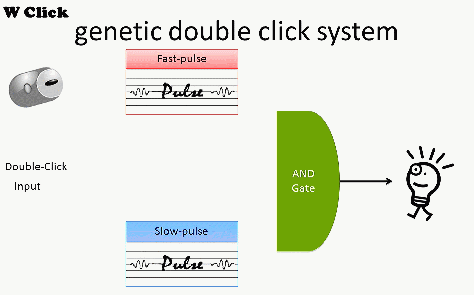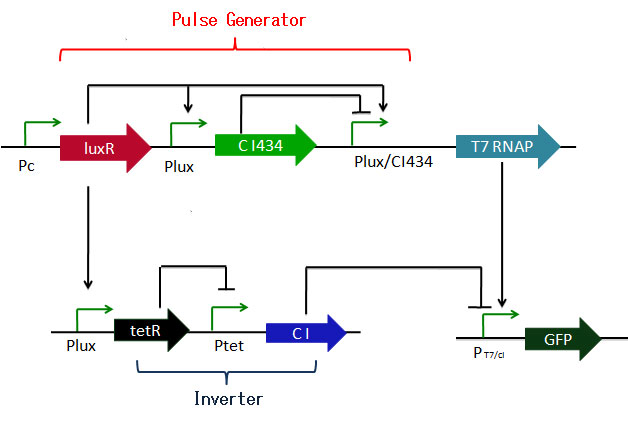Team:Chiba/System 1
From 2010.igem.org
| Line 360: | Line 360: | ||
==Circuit Construction== | ==Circuit Construction== | ||
| - | [[Image:Chiba_plan2_1.jpg|right|500px]]This system consists of a pulse-generator and two inverters which can be seemed as a slow pulse.In this system, we also use AHL input and GFP output. This time, we use AHL as an activate signal, so when there is AHL added, Lux promoter will be activated. The transcription factors of output are T7 RNA Polymerase and cI repressor. | + | [[Image:Chiba_plan2_1.jpg|right|500px]]This system consists of a pulse-generator and two inverters which can be seemed as a slow pulse.In this system, we also use AHL input and GFP output. This time, we use AHL as an activate signal, so when there is AHL added, Lux promoter will be activated. The transcription factors of output are T7 RNA Polymerase and cI repressor.[[Team:Chiba/System 1/Design|detail...]] |
| + | ==Results== | ||
| + | ===Testing individual parts=== | ||
| + | To realize the genetic double click system, we made two plasmids. First one is “GFP generator”, which generates the output (GFP expression) on condition that T7 RNAP activates the GFP upstream promoter and also CI protein does not repress that promoter. Second one is “Pulse generator”, which generate the pulse of T7 RNAP in response to the 1st and 2nd input. The subparts of those plasmids are shown below. | ||
| + | [[Image:Chiba_icon_1.jpg]] | ||
| + | Regarding with those two plasmids, we tested the function of each parts in the plasmids. | ||
| + | For GFP generator, the parts shown below were checked. | ||
| + | #Constitutive promoter | ||
| + | #LuxR | ||
| + | #T7/CI-OR1 hybrid promoter | ||
| + | For Pulse generator, the parts shown below were checked. | ||
| + | #Lux/CI434 hybrid promoter | ||
| + | #Pulse generator | ||
| + | Also, we checked if there were no crosstalk between CI/CI434 and CI promoter/CI434 promoter. | ||
| - | + | ===Construction=== | |
| - | + | ===Evaluating Core Devices=== | |
| - | + | ===Whole System=== | |
| - | + | ||
| - | + | ||
| - | + | ||
| - | + | ||
| - | + | ||
| - | + | ||
| - | + | ||
| - | + | ||
| - | + | ||
| - | + | ||
| - | + | ||
| - | + | ||
| - | + | ||
| - | + | ||
| - | + | ||
| - | + | ||
| - | + | ||
| - | + | ||
| - | + | ||
| - | + | ||
| - | + | ||
| - | + | ||
| - | + | ||
| - | + | ||
| - | + | ||
| - | + | ||
| - | + | ||
| - | + | ||
| - | + | ||
| - | + | ||
| - | + | ||
| - | + | ||
| - | + | ||
| - | + | ||
| - | + | ||
| - | + | ||
| - | + | ||
| - | + | ||
| - | + | ||
| - | + | ||
| - | + | ||
| - | + | ||
| - | + | ||
| - | + | ||
| - | + | ||
| - | + | ||
| - | + | ||
| - | + | ||
| - | + | ||
| - | + | ||
| - | + | ||
| - | + | ||
| - | + | ||
| - | + | ||
| - | + | ||
| - | + | ||
| - | + | ||
| - | + | ||
| - | + | ||
| - | + | ||
| - | + | ||
| - | + | ||
| - | + | ||
| - | + | ||
| - | + | ||
| - | + | ||
| - | + | ||
| - | + | ||
| - | + | ||
| - | + | ||
| - | + | ||
| - | + | ||
| - | + | ||
| - | + | ||
| - | + | ||
| - | + | ||
| - | + | ||
| - | + | ||
| - | + | ||
| - | + | ||
| - | + | ||
Revision as of 01:02, 28 October 2010

Contents |
Version 1
Overview
“Genetic double click system” - version 1 is based on the AND-gate which is switched only when same inputs are given two times in quick succession. This system requires the operations which never happen naturally to turn the switch. So, we believe that this is very safety device. This system requires that a first input is transient in order to allow a second input. Unlike chemical inputs, light inputs are very suitable for this system because it does not remain after inputting. But, there is not light sensor with good sensitivity. So, we produced artificially transient input by AHL inputting and washing. Next, this system is required to memorize the transient first input since this system is based on AND gate. In addition, this system requires fixed time between the first and the second input like a computer mouse to recognize double-click and two separated single-clicks as different, so, this system is required to memorize the transient first input temporarily.In our first design, we decided a pulse-generator to memorize the input temporarily. And, we designed the system which is based on combination of a Fast-pulse and a Slow-pulse in principle as shown in the following figure. detail...
Circuit Construction
This system consists of a pulse-generator and two inverters which can be seemed as a slow pulse.In this system, we also use AHL input and GFP output. This time, we use AHL as an activate signal, so when there is AHL added, Lux promoter will be activated. The transcription factors of output are T7 RNA Polymerase and cI repressor.detail...
Results
Testing individual parts
To realize the genetic double click system, we made two plasmids. First one is “GFP generator”, which generates the output (GFP expression) on condition that T7 RNAP activates the GFP upstream promoter and also CI protein does not repress that promoter. Second one is “Pulse generator”, which generate the pulse of T7 RNAP in response to the 1st and 2nd input. The subparts of those plasmids are shown below.
![]() Regarding with those two plasmids, we tested the function of each parts in the plasmids.
For GFP generator, the parts shown below were checked.
Regarding with those two plasmids, we tested the function of each parts in the plasmids.
For GFP generator, the parts shown below were checked.
- Constitutive promoter
- LuxR
- T7/CI-OR1 hybrid promoter
For Pulse generator, the parts shown below were checked.
- Lux/CI434 hybrid promoter
- Pulse generator
Also, we checked if there were no crosstalk between CI/CI434 and CI promoter/CI434 promoter.
 "
"

